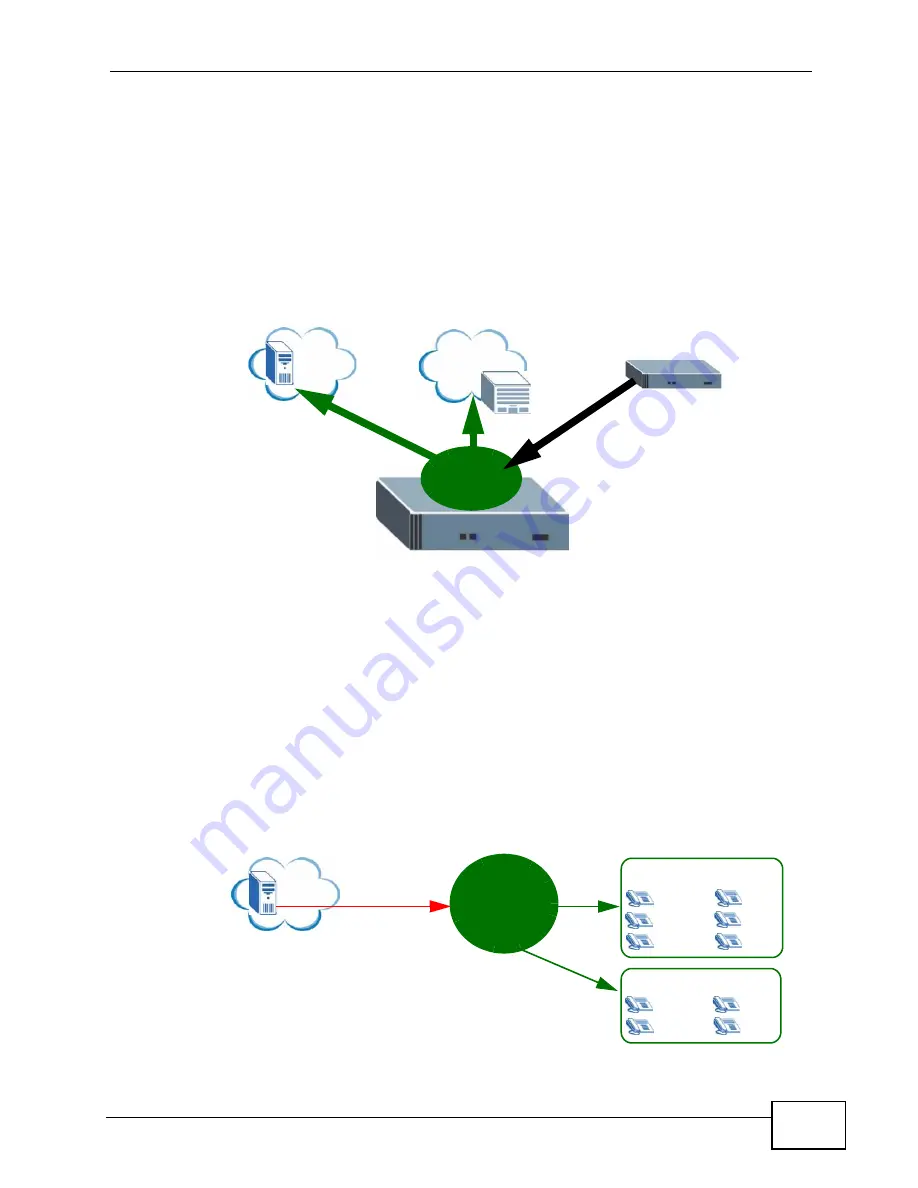
Chapter 21 Group Management
X2002 User’s Guide
317
•
LCRs
(LCR is the outbound dialing rule) - When you create links from an
outbound line group to an LCR, you allow incoming calls from that outbound line
group to make outbound calls via the outbound line groups configured in the
LCR. For example, someone calling from outside your organization can use the
X2002 to forward their call to another outside line.
In the following example, outbound line group
TrustedPeer
is associated with
LCR1
.
LCR1
is comprised of two outbound line groups: a SIP trunk to your VoIP
service provider -
ITSP
and a connection to your local traditional telephone
company -
PSTN/ISDN
. Calls coming in via the
TrustedPeer
connection can
use the
ITSP
and
PSTN/ISDN
connections to complete their calls.
Figure 188
Group Management - Outbound Line Group to LCR
•
Ring Groups
- Links from an outbound line group to a page or hunt group are
known as a ‘ring group’. You can allow calls coming in via that outbound line
group to call the page or hunt group configured within the ring group.
In the following example, outbound line group
Sales
is associated to
Ring
Group A
.
Ring
Group
A
consists of:
•
Page
Group
1
:
allows you to call all the extensions within
Page
Group
1
simply by dialing the page group number (
888
).
•
Hunt
Group
1
: allows you to call extensions within
Hunt
Group
1
based on
the algorithm defined in the hunt group setup simply by dialing the hunt
group number (
999
).
All calls coming in via the outbound line group
ITSP
can call
Page Group 1
or
Hunt Group 1
.
Figure 189
Group Management - Outbound Line Group to Ring Group
Internet
ITSP
PSTN
TrustedPeer
LCR1
/ ISDN
Ring Group A
Hunt Group 1
Page Group 1
888
999
1001
1002
1003
1004
1005
1006
1006
1007
2005
2003
Internet
ITSP
Summary of Contents for X2002
Page 2: ......
Page 24: ...Table of Contents X2002 User s Guide 24...
Page 25: ...25 PART I User s Guide...
Page 26: ...26...
Page 40: ...Chapter 2 How It Works X2002 User s Guide 40...
Page 99: ...99 PART II Technical Reference...
Page 100: ...100...
Page 124: ...Chapter 5 Network Deployment X2002 User s Guide 124...
Page 166: ...Chapter 7 Auto Provision X2002 User s Guide 166...
Page 170: ...Chapter 8 QoS X2002 User s Guide 170...
Page 248: ...Chapter 16 Click To Talk Group X2002 User s Guide 248...
Page 252: ...Chapter 17 Group Access Code X2002 User s Guide 252...
Page 304: ...Chapter 19 Auto Attendant X2002 User s Guide 304...
Page 312: ...Chapter 20 LCR X2002 User s Guide 312...
Page 346: ...Chapter 22 Call Services X2002 User s Guide 346...
Page 380: ...Chapter 25 Status Observation X2002 User s Guide 380...
Page 402: ...Chapter 27 Call Detail Record CDR X2002 User s Guide 402...
Page 410: ...Chapter 28 ACD Logs X2002 User s Guide 410...
Page 416: ...Chapter 29 Administrator Accounts X2002 User s Guide 416...
Page 424: ...Chapter 30 Diagnostics X2002 User s Guide 424...
Page 426: ...Chapter 31 X2002 User s Guide 426...
Page 446: ...Chapter 32 Remote Management X2002 User s Guide 446...
Page 448: ...Chapter 33 TFTP Management X2002 User s Guide 448...
Page 462: ...Chapter 35 License Control X2002 User s Guide 462...
Page 482: ...Chapter 36 Web Portal X2002 User s Guide 482...
Page 508: ...Chapter 39 Product Specifications X2002 User s Guide 508...
Page 548: ...Appendix C Legal Information X2002 User s Guide 548...
Page 562: ...Index X2002 User s Guide 562...














































